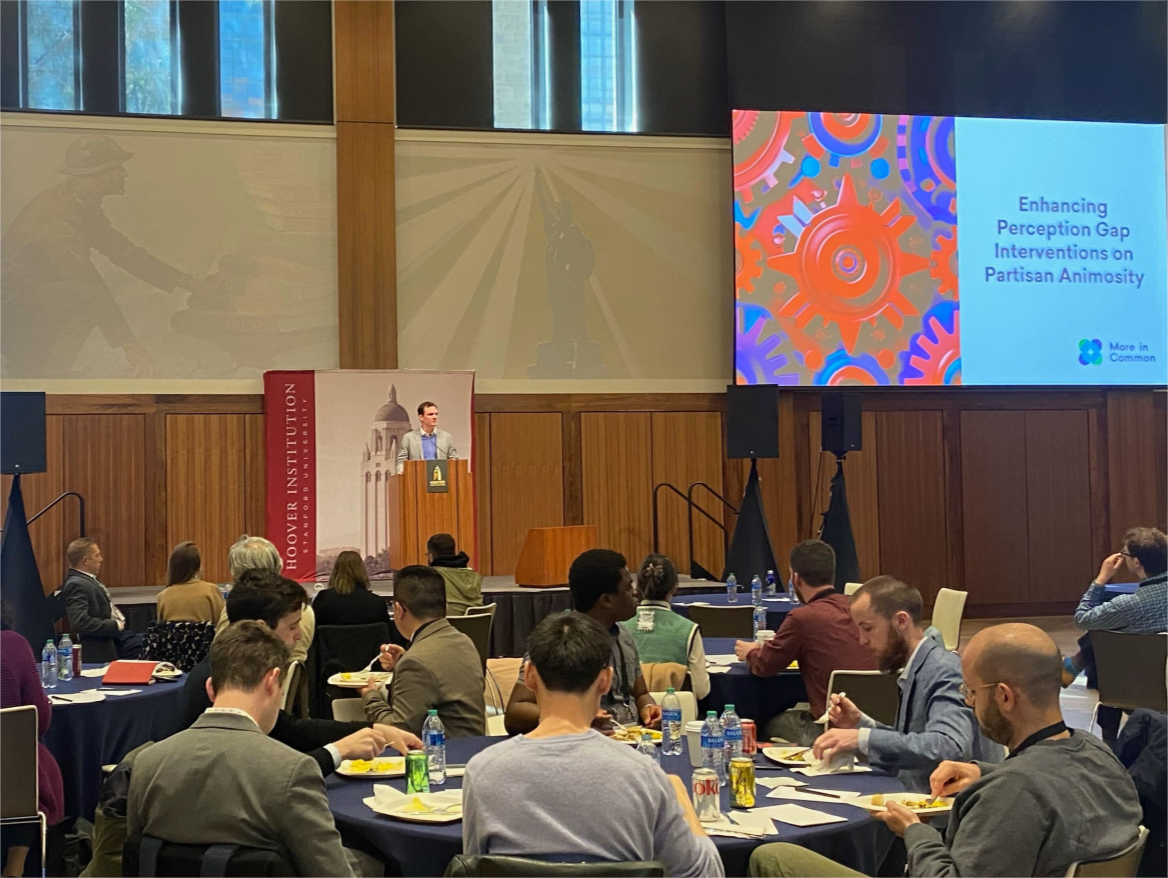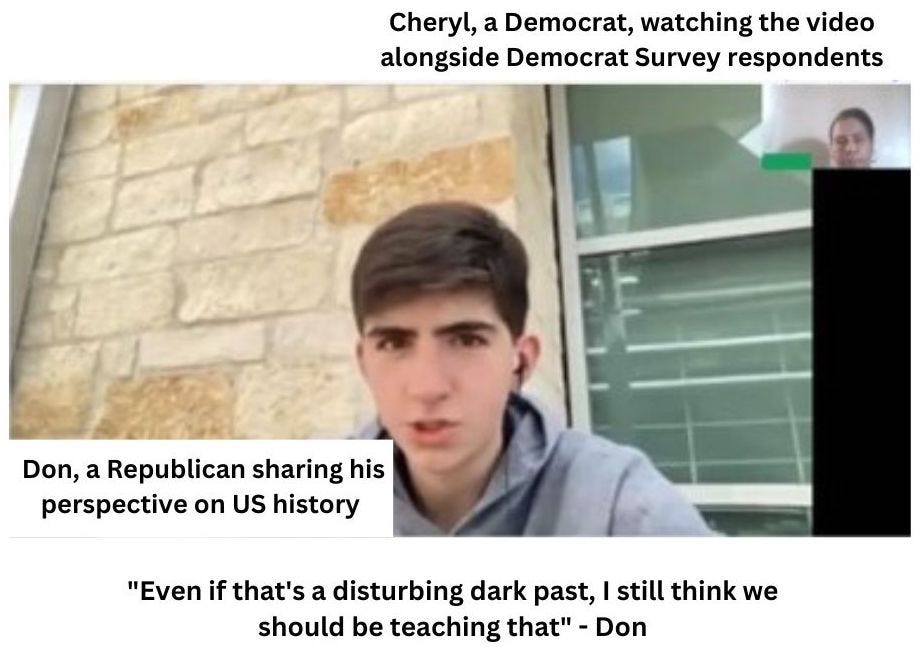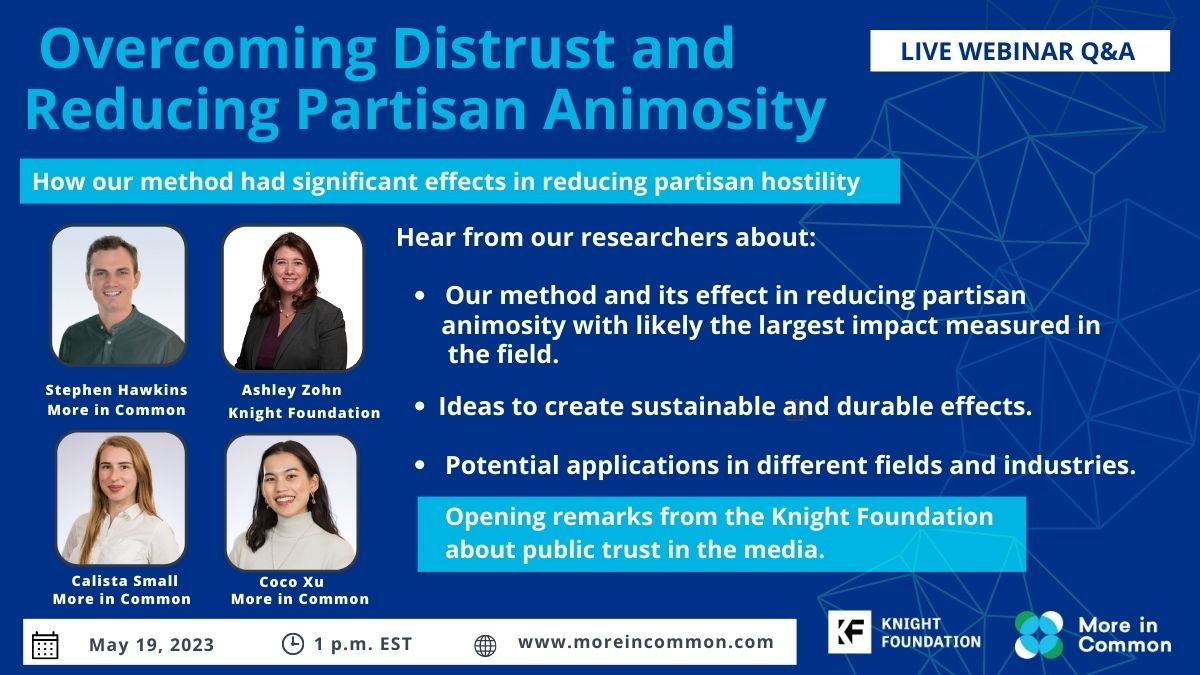New Study: A Promising Method to Build Trust in Information and Reduce Partisan Animosity
Summary: A new video method developed by More in Common significantly reduced feelings of hostility between political party members to a level that resembles the political climate of the 1980s, when Republicans and Democrats held close-to-neutral feelings towards one another. To learn more, sign up for our webinar on May 19th.
Stephen Hawkins, More in Common’s Global Director of Research, presented our findings at the Polarization Research Lab’s annual conference to an audience of academics and experts in the field of polarization.
Why is it important to reduce feelings of hostility between Democrats and Republicans?
Feelings of hostility between political parties, known to researchers as “partisan animosity,” have been steadily increasing in the US since the 1980s. Partisan animosity is captured through measuring negative feelings Americans have towards a political outgroup (opposite political party) on a 100 point scale.
As partisan animosity increases, general social distrust increases as well.1 Individuals start to physically and socially distance themselves from people who belong to a different political party. Politically: collaboration ends.2 Personally: relationships fall apart.3 Nationally: the country’s trust in democracy is significantly threatened.4
How does our video method increase trust and reduce partisan animosity?
The hypothesis of this project draws on the concept of “perception gaps”, misunderstandings or exaggerations about how other people think. For example, in our Defusing the History Wars report, we found that Republicans think only 43% of Democrats agree with the statement “students should not be made to feel guilty or personally responsible for the failures of prior generations,” when, in fact, 83% of Democrats agree.
But our prior research also discovered that presenting perception gap data alone (such as the statistics above) was not enough to convince audiences that the average member of the opposing party is not as threatening or extreme as they think.
To address these challenges, we used our Defusing the History Wars report insights to produce video content. The videos aimed to increase the credibility of perception gap statistics by incorporating two key elements: (1) leveraging personal stories and (2) using members of the viewer’s own political party as messengers.
A screenshot from our video that includes footage of a Democrat, Cheryl, watching and reacting positively to a Republican, Don, talking about his perspective on how American history should be taught.
We then tested the ability of the videos to decrease feelings of hostility between Democrats and Republicans. The combination of the two key elements had a powerful effect:
The videos significantly lowered feelings of partisan animosity by 20 points on a 100-point scale. As shown below, the method was almost twice as effective as the top performing approaches that were a part of Stanford University’s Strengthening Democracy Challenge, an initiative that tested 25+ methods developed and submitted by academics and practitioners that aimed to reduce partisan animosity.
While we found the durability of the effects were brief, their magnitude suggests that adopting new methods and strategies in sharing information has potential to defuse tensions, increase trust in data, and improve our understanding of one another.
Want to learn more?
There are many possible applications for our method—as well as questions. How do we make the results more durable? How broadly can this method be applied? What other tools can we incorporate using this method?
Join our upcoming webinar on May 19th to learn more about this study and its potential applications along with opening remarks and data about public trust in the media from Ashley Zohn, Vice President of Learning and Impact at the Knight Foundation, who supported this project.
🗯 Join the conversation and learn more about our newest study. Sign up for our virtual Q&A Friday, May 19th at 1 p.m. EST.
References:
More in Common, Two Stories of Distrust in America, https://www.moreincommon.com/media/yfcbfmmp/mic_two-stories-of-distrust.pdf
Zachary P. Neal, “A sign of the times? Weak and strong polarization in the U.S. Congress, 1973–2016,” Social Networks, Volume 60, January 2020, https://www.sciencedirect.com/science/article/abs/pii/S0378873317303039?casa_token=4CoQYFgFdxoAAAAA:MDCtnBrWpnEtSoHKlr__OqzvaUxI7_Z2aAB4KfGLL6BJYErFume0-5jHR4bTeMFlslJQC8SZ
Shanto Iyengar et al., “The Origins and Consequences of Affective Polarization in the United States,” Annual Review of Political Science, Vol. 22, May 2019, https://doi.org/10.1146/annurev-polisci-051117-073034
John Kingzette et al., “How Affective Polarization Undermines Support for Democratic Norms,” Public Opinion Quarterly, Volume 85, Issue 2, Summer 2021, https://doi.org/10.1093/poq/nfab029





